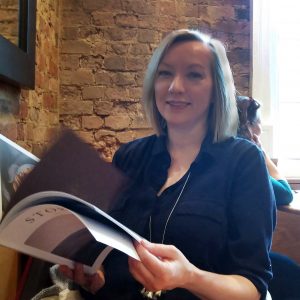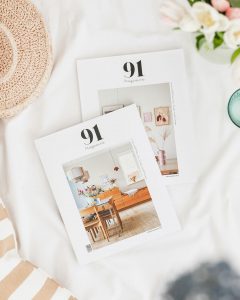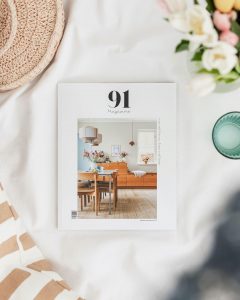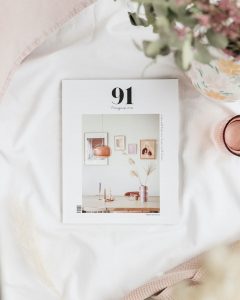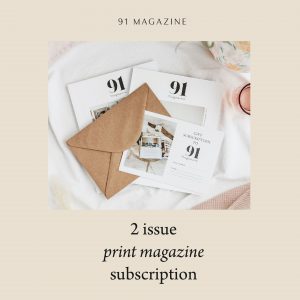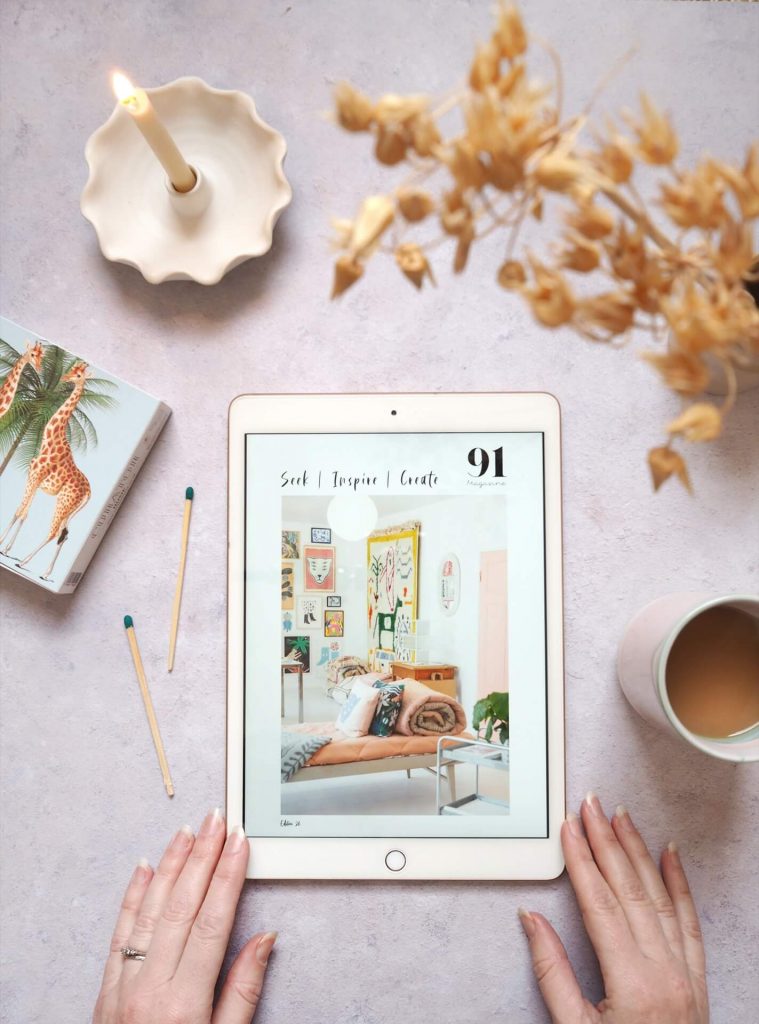Hi Jess, tell us about your characterful creations…
I make handmade ceramic curiosities with a story to tell. Partly ornamental, partly practical; they have an imaginative narrative with anthrozoologic themes. That’s quite long-winded however, so I usually just say I make ‘conversational ceramics’, or animals out of clay.

What’s the story behind the name Dóttir?
Dóttir translates as ’daughter’ in Icelandic. I began working in clay after my daughter was born and chose the name because I wanted to reflect on this personal event that led me in a new direction. Iceland is a special place for us as a family, my husband proposed to me on the black sand beach at Reynisfjara, and we also married there, in the little black church of Búðir on the Snæfellsnes peninsula.
When we first started visiting many years ago, I fell in love with the country and the landscape there, it’s where I think magic exists. I’m often asked if I’m Icelandic because of the name, but I’m not. It’s the magic I felt whilst visiting that inspires my work and really helped motivate me to make the jump and work for myself too.

What inspired the idea of setting up your business?
I had been collecting handmade ceramics for a few years, pieces by Atelier Stella and Alex Sickling. I was fascinated by how they were made, and loved that no two pieces were the same. At the time, I worked as a surface pattern designer sitting behind a computer all day and feeling pretty miserable about it. The pull of ceramics and the physical act of making something with my own hands was too great. I started reading articles, blogs and forums in the evenings to find the answers to my natural curiosity, and the obsession just grew.
I’d wanted to work for myself for a long time, but my confidence had been eroded and I had terrible ‘imposter syndrome’. But while on maternity leave, I realised what a positive effect being away from the office environment was having on my mental health, so decided to really go for it.
I was lucky in that we had just moved to a bigger house, so I could set up a small studio in our garden. I took a short course at my local university and then some classes with a fantastic ceramicist near me called Elly Wall, who also really inspired me to go for it.
Dóttir began in October 2018. What then pushed me was applying for the local art market near where I live. It gave me a deadline, so I worked my socks off to meet it. I initially made three collections – one graphic, reflecting my experience as a surface pattern designer, one seasonal, and one of animals because this was what I liked to make. The market was a huge success and Dóttir has been growing ever since. I soon dropped the graphic direction, it didn’t feel authentic and was too much like my previous life. Animals have remained, alongside the appearance of a few face pots, moons and other oddities.

What did you do before setting up your business?
I studied an MA in illustration at Brighton University. For my final project I created an artist book about sea lions, for which I worked with a colony near La Paz, Mexico. I would go out and photograph and draw the pups underwater… I had the time of my life. After that, I worked in Mexico for a shark conservation charity, designing all their branding and working on material for them to take into fishing camps to educate the children about how awesome sharks are. They were the golden years after graduating, I did tons of travelling and spent a lot of time scuba diving and in the sea. And I was happy because I was combining my love of animals with my art practice, something I have always subconsciously sought to marry.
When I returned home, I got swept up in the world of commercial design. I worked in graphics, surface pattern, stationery and fashion. I spent a few years working in Vancouver, Canada, where I met a lot of amazing creatives who inspired me greatly. When I returned home, I struggled to find where I fitted professionally. Soon after that I met my husband and we started making plans together – he has been hugely instrumental in supporting me to find the right direction.

Where do you find your inspiration?
Childhood memories, encounters with animals, story books that resonated with me while I was young. ‘Masquerade’ had a big impact on me – the book was a treasure hunt to find a jewelled hare buried in the UK countryside, the illustrations held the clues to where, and each had a hidden hare. Hares frighten me a little, though fascinate me equally. That’s why they appear in my work so often.
I’m inspired by myth and folklore, particularly from the Pacific Northwest. The idea of a shape-changer, or an animal as a spirit guide is almost like someone else putting into words the feeling I’ve had since childhood. I am greatly inspired by the work of Kiki Smith and Vicky Lindo, both great storytellers. But I try not to look too much at things like Pinterest, as it’s easy to be influenced by ‘trends’. I try to focus on what makes me tick rather than what everyone else doing.

How would you describe your style?
I would say it’s illustrated, reminiscent of a children’s book or childhood memory. My pieces have a lot of personality too, even if I make five black cats, they’ll all be slightly different – just like real cats. Everything I make is hand-built, so it has a slightly wonky handmade feel to it. I don’t use a wheel to throw anything, I use coils and slabs to build my pieces, and then sculpt out features with my hands and tools.
Are there themes that run through your work?
There is always the theme of a story being told, a journey. It might not be obvious from seeing a single piece in isolation, but they are all part of a bigger picture that I have running in my head. It’s quite difficult to explain without sounding like I’ve lost the plot, but I know it when I feel it. If I can see an animal, moon or figure appear in the scene of that story then I know it will work. When I try and force a character, it’s never as successful.
How did you first discover your love for what you do?
The weekend classes at my local university taught the basics, and I remember sitting making pinch pots, thinking how good it felt to physically make something with my hands. Only by growing my skills with clay and stretching my imagination have I found the direction. Each batch I make, I feel like I’m making a step forward in terms of creative development. I’m still in the early days of Dóttir so I know I still have a long way to go to finally achieve my ‘look’, but I’m loving every minute of the journey to get there.

Could you describe a working day?
Once I’ve dropped my daughter off at nursery, I make a cup of tea in my favourite handmade mug and switch my computer on. Talula, my pug, is always at my side, so she will settle down in her bed. If it’s a making day, I’ll open an audiobook or a podcast, then I’ll get the clay out. I’ll have a list of pieces I need to make, but sometimes, I’ll veer away from that and make what I feel like. This isn’t the most structured way to work, but I often find I’ll make something unplanned that turns out really exciting – this is how I started making cat vases. I’ll work like this until it’s time to collect my daughter, then when she’s gone to bed, I’ll come back and work some more, finishing off pieces before I set them aside to slowly dry.

Is there an ethos behind your business?
I would like my work to remind people of the beauty of the natural world and have a bit more empathy for our wildlife. It’s easily forgotten with our hectic daily schedules, but I hope that if someone picks up a badger bottle stopper it will remind them of how beautiful badgers are and how hard a life they have.

What is your work process?
I have a sketchbook for ideas, I find they come quite easily and it helps to work out the engineering when building a piece. With a concept I’m really excited about, I just want to get on and make it, so sometimes it’s easier to do that rather than looking at it in 2D.
I use earthenware clay for items that are highly illustrated, but I get really excited by stoneware – I love a naked clay surface, I just think it’s beautiful. So I use a few different speckled and flecked stoneware clays – these will only have a single colour on them.
I try and make a batch every 4-6 weeks, so I’ll be making with wet clay for a third of that time, illustrating with underglazes onto the clay as it dries another third, then bisque firing. Then I’ll glaze everything and start the glaze firing cycle for the final third, depending on the clay body and glaze.

What sort of space do you work in?
I’m very lucky to have a brick outhouse in my garden that my husband converted for me (it was full of spiders and we also found some hedgehogs living there too!). Initially I had planned to work out there all the time, but now I use it as my kiln room and stock room. There’s also a small study where I have two desks, one for clay and one for my computer. There is hardly any room in there to move, especially when you add in my dog and her bed!

What is your neighbourhood like?
I live in a small village near Hitchin in Hertfordshire. It’s quite rural, as I prefer the peace and quiet of the countryside. We moved here from a much bigger town where we lived on a busy road. It’s easy to say I’m much happier now, I feel closer to nature. I can also hop on a train and be in London in 25 minutes, so I still feel connected to the capital. I know lots of lovely local makers here and I feel really lucky to be part of a community with so much talent.
Has your work evolved since you began?
Tremendously, and I think it will continue to do so. I began by thinking I should be using my industry experience and designing trend-led graphic prints on homeware items. I did this at the beginning, but it didn’t feel authentically me, what really made my heart sing was to step away from the commercial washing machine of ‘trends’ and find my own voice.
Animals have always been a huge part of my life, and I’ve found a way to combine my art practice with what I love most. It’s been a long journey, which I am still on, but I am happy to have finally found a place the two can meet again.

How valuable is the online community to your work?
It’s such a boost to me. I’m not sure I would have made the jump in the days before Instagram. I think that’s why it took me so long to leave the security of salaried employment, as it was so unknown. Both the friendships I’ve forged with other makers and the feedback I’ve received from followers have been essential to so many decisions I’ve made within the business. It keeps me going whenever I doubt myself too.

What are the joys and the challenges of being an independent maker?
I love it, I can’t imagine it any other way now. You can work on your own practice, whatever you chose that to be, and if you work hard enough then you can make things happen. That in itself is incredibly rewarding. I get so much enjoyment from making my own creative decisions, planning my time and making customers happy with either their commissioned pieces or their custom pet designs. Getting feedback from customers who are happy with the pieces I’ve made for them is honestly the best feeling.
But stepping away from a salaried position is a big leap, so it needs planning. You’ve got to wear a lot of hats when you’re self-employed; you need to able to keep accounts, do admin, and box up shipments – which all take a big bite out of your working day. There’s also a lot of pressure to come up with new ideas and new products. You can end up working long hours, too, but the positives outweigh the negatives, hands down.

How do you approach marketing and PR?
This is probably the area I struggle with the most. I’m so busy making that I tend to neglect this side of my business. Every PR or marketing opportunity has fortunately found me so far, but I am aware I should be more pro-active about promoting myself and Dóttir. I’ve made my next goal to improve my product photography and spend more time updating my followers with what I’m up to. But I really struggle with stage fright when posting online.

What have been your business highlights so far?
The first that springs to my mind was last Christmas when I got to work with UK clothing brand, Stalf on a collaboration. The owner, Paris, approached me about making some custom planters to be part of a pop-up shop they were planning. I live in Stalf clothing so I was already a huge fan and was delighted to work on something with them.

Where do you show and sell your work?
Mostly through my website, www.dottir.studio, and post on Instagram when I’m about to do a shop update. I also stock some of my designs on Not On The High Street, and a few bricks and mortar stores. I’ve also shown with a few galleries too, which I would love to do more of. I participate in lots of art markets, mostly in London and the Midlands. My favourite market is Paperdolls Handmade at The Custard Factory in Birmingham – it’s such a great venue, the line-up is always very well curated and everyone is really friendly.

Which pieces do you most enjoy making?
I enjoy sculpting animal features the most, creating facial features, ears and profiles. Product-wise, I enjoy making the custom pet pieces as they all have different personalities, so each one is different. I’m not very good at making the same thing over and over! It gives me such a buzz when I see the animal in my mind begin to emerge from the lump of clay.
Do you have any creative pastimes or hobbies?
Mostly Playdoh and hand-printing with my daughter! She loves being in my studio with me and ‘helping’. I’ve been doing lots of gardening this year and growing my own vegetables, but I haven’t got it in me to stop the caterpillars from eating my broccoli, so I’m not sure I’m a very good horticulturist!

Any good advice for makers who are just starting out?
Yes, just start. Get your work out there, opportunities will come if you’re out there. You can’t imagine what they will be yet, but just get going and be authentically you. Oh, and try and save a pot of money before you jump, you’ll need it at the beginning.
What does the next 6 months hold for you?
More animals, I’m currently developing some new totems and also beginning to branch out into making jewellery. I recently made some animal headed bottle stoppers and working in a smaller scale was good fun, so I’m going to try even smaller and maybe make some necklaces. Keep an eye out for tiny polar bears!
Quickfire questions:
Describe your work in three words?
Whimsical, wonky, magic.
What are your making rituals?
All my animals have to face another in the kiln or else they’ll be lonely. I can’t close the kiln lid if I think one is left out.
Tea or coffee?
Tea, I’ll only drink coffee in an espresso martini.
Mountains or sea?
Ideally both. If I had to choose, then it’ll always be the sea, as I love marine life so much.
Night owl or early bird?
When I asked my husband what he thought to this question, he said I was ‘a midday magpie’ because I’m neither.
I wish someone had told me…
Everyone has imposter syndrome – even the makers you aspire to be like.
Hard work beats talent. But if you have talent and you work hard, that’s when good thing happen.
Find out more about Dóttir via their website and on Instagram.


